#BOSTON MARATHON FASTEST TIME
Explore tagged Tumblr posts
Text
Geoffrey Mutai Fastest time in the Boston Marathon and Beyond
Name: Geoffrey Mutai Achievement: Fastest time in the Boston Marathon Boston Marathon winning year: 2011 Boston Marathon time: 2:03:02 Geoffrey Mutai, a name that resonates with unparalleled prowess and a testament to human determination, has etched his mark on the annals of long-distance running history. Born on October 7, 1981, in the rural highlands of Bomet County, Kenya, Mutai emerged…
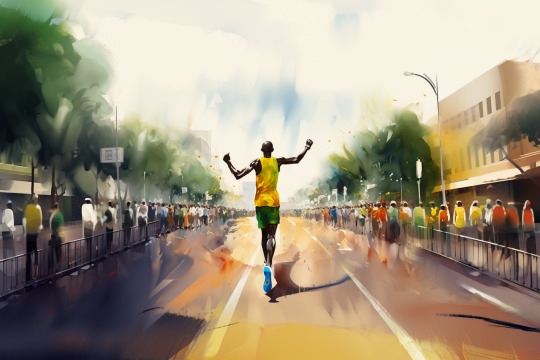
View On WordPress
#achievements#Assorted Flavors#Assorted Fruity Flavors#athlete#athletic achievement#best time boston marathon#Boston Marathon#Boston Marathon best time#BOSTON MARATHON FASTEST TIME#Clif Bar#Cycling#Cycling Snack#dedication#Determination#distance runner#Energy#Energy Chews#excellence#Fast Fuel#fastest man#fastest marathon#fastest time in the Boston Marathon#Geoffrey Mutai#greatness#GU Energy#human potential#Innovation#inspiration#Kenya#long-distance running
0 notes
Text
Here. Have some photographic proof. Here's Kathrine Switzer (261), the first woman to run the Boston Marathon, being assaulted by race co-director Jock Semple (asshole in dark clothing) due to his belief that women shouldn't run marathons. (Many people at the time believed women were physically incapable of running that far, despite all the women, including Switzer, who had done so previously.)

Switzer finished the race, there was a huge to-do about it, and the photos became an iconic piece of women's sports history.
So yes. Women can sports. They can sports alongside men, even. Switzer was not the fastest runner in Boston that day, but she wasn’t the slowest, either. She was still running marathons as recently as 2017, a full fifty years after these photos were taken. She ran Boston that year, in a cohort that was nearly 50% women.
If you're on Jock Semple's side, you're on the wrong side of history.
do u remember when the wider feminist position on gendered sport was that we should abolish it, and that women's accomplishments can be measured side by side (& indeed, neck and neck) with men's? what the fuck happened to that? (*whispering* i know what happened. it was the terf movement.)
49K notes
·
View notes
Text
Pakistani runners clock sub-four-hour finishes at 2025 Boston Marathon
Thirteen Pakistani runners achieved sub-four-hour finishes at the 129th Boston Marathon on Monday, with Amin Mukaty and Sara Lodhi emerging as the country’s fastest male and female finishers at the prestigious World Marathon Major. Amin Mukaty, 23, clocked 2:48:47 on the storied course, becoming the fastest Pakistani male finisher. The Karachi-based runner, who qualified on time, posted on…
0 notes
Text
Life is Not A Spectator Sport
What are your favorite sports to watch and play? At one time I excelled in traditional American sports. I was rather decent at baseball and football but lost interest as an adult. I spent many a year being a competitive runner. I have my fastest marathon time at The Boston Marathon. I still run a little. However, I fell in love with soccer about twenty years ago. It is the only sport I watch.…
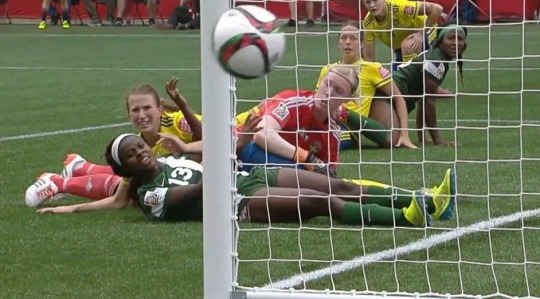
View On WordPress
0 notes
Text
Unveiling Custom 5K Medals at the Boston Marathon
Introduction:

Exploring the Essence of 5K Medals:
At the core of any iconic event lies its medals — and their meaning for participants. Beyond their shiny surfaces lies an inspiring story of determination and achievement; tangible reminders of journey taken, obstacles overcome, goals reached. Whether it’s the glint of 5K gold or the elegance of a custom-crafted design, each medal holds a unique tale of triumph. Exploring Past 5 Years’ Medals:
Year Medal Material Symbolic Meaning
2023 Bronze Steadfastness
2022 Silver Achievement and Honor
2021 Gold Highest Honor and Glory
2020 Silver Progress and Moving Forward
2019 Bronze Perseverance and Endurance
Each medal material and its symbolic meaning encapsulate the essence of the Boston Marathon, honoring the dedication, perseverance, and triumph of all those who participate in this iconic event.
Delving into the Tradition:
As we reflect back over 10 years of the Boston Marathon, we see an array of remarkable feats and unforgettable moments. From 5K medals awarded to fastest runners to cheers of encouragement along the route, each year adds new chapters to its rich legacy. Let’s take a closer look at some standout performances and people who etched themselves into history:
MEN’S OPEN DIVISION
Year Name Country Time
2023 Evans Chebet Kenya 2:05:54
2022 Evans Chebet Kenya 2:06:51
2021 Benson Kipruto Kenya 2:09:51
2019 Lawrence Cherono Kenya 2:07:57
2018 Yuki Kawauchi Japan 2:15:58
2017 Geoffrey Kirui Kenya2:09:37
2016 Lemi Berhanu Ethiopia 2:12:45
2015 Lelisa Desisa Ethiopia 2:09:17
2014 Mebrahtom “Meb” Keflezighi United States 2:08:37
2013 Lelisa Desisa Ethiopia 2:10:22
WOMEN’S OPEN CHAMPION
Year Name Country Time
2023 Hellen Obiri Kenya 2:21:38
2022 Peres Jepchirchir Kenya 2:21:01
2021 Edna Kiplagat Kenya 2:25:09
2019 Worknesh Degefa Ethiopia 2:23:31
2018 Desiree Linden United States 2:39:54
2017 Edna Kiplagat Kenya 2:21:52
2016 Atsede Baysa Ethiopia 2:29:19
2015 Caroline Rotich Kenya 2:24:55
2014 Buzunesh Deba Ethiopia2:19:59*
2013 Rita Jeptoo Kenya 2:26:25
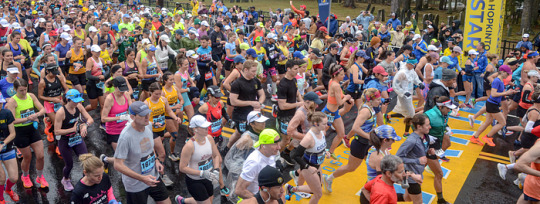
Crafting Excellence: Custom 5K Medals by Hesank:
At Hesank, we understand the significance of honoring such monumental achievements with custom 5K medals that capture their essence — that’s why our meticulous craftsmanship and attention to detail ensure that each one stands as its own masterpiece. Start a journey of grandeur with our Soft Enamel 5K Marathon Medal, meticulously crafted to symbolize your unfaltering dedication. No matter if it is your first or fifth run, our medals serve as tangible symbols of excellence for athletes of any level, offering full customization options so your medal reflects who you are as an individual and reflects all that has gone into creating it!
Conclusion:
While we commemorate the legacy of the Boston Marathon and all those who grace its hallowed grounds, let us not lose sight of how important 5K medals are in commemorating their achievements. Whether a runner pursuing greatness on the race course or an avid spectator cheering from the sidelines, medals serve as lasting symbols of perseverance, unity and triumph — something Hesank takes great pleasure in upholding through crafting custom 5k with medals that uphold and encourage everyone who wears one. Come join us in honoring athleticism’s pursuit as we journey closer towards victory together at Hesank!
0 notes
Text
Qualifying for the Boston Marathon
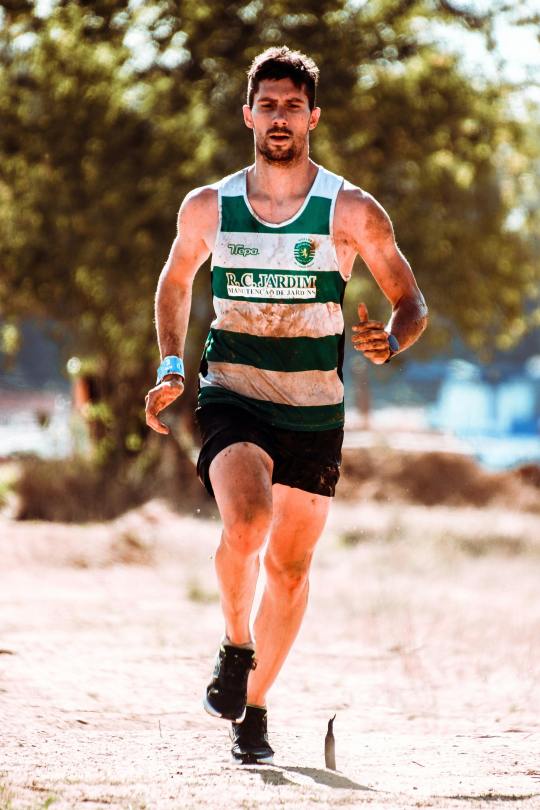
Inspired by the Olympic Marathon, the Boston Marathon was established in 1897 and has occurred annually ever since. The first race spanned from Ashland, Massachusetts, to Boston, attracting 15 participants. In 1924, the organizers extended the course to align with the Olympic distance of 26.2 miles. Over the decades, runners from across the globe have flocked to participate in this marathon, solidifying its position as one of the most renowned races worldwide.
The marathon's route begins at Hopkinton, with runners passing through Ashland, Framingham, and Wellesley and mountainous areas like Newton as they make their way toward the finish line at Copley Square in Boston. The course features tough terrains and variable road conditions. It begins with a slight downhill slope, but the terrain becomes more demanding as runners approach the hills around Newton. One particularly challenging section for runners is Heartbreak Hill, known for its steep incline.
The Boston Marathon typically permits 20,000-38,000 total participants annually, depending on safety and other factors.
Official entry into the marathon requires attaining a qualifying time at the Boston Qualifiers. The qualification standards vary by gender and age group and are updated periodically. Cutoffs range from three hours for 18- to 34-year-old men to three-and-a-half hours for same-aged women. Older participants have slightly longer qualifying times, with some exceeding four hours. Depending on application volume, the marathon subtracts from the qualifying time a "cutoff time," which lowers the qualifying time. For the 2024 race, the "cutoff time" is 5:29, meaning the time a man between the ages of 18 and 34 would have had to run a 2:54:31 marathon or faster to be accepted into the race.
Registration for this marathon typically opens in September. Qualified runners register online by submitting their qualifying time details and paying a registration fee. For the 2024 race, the registration fee was $230 for residents of the United States; the fee is slightly higher for residents of other countries.
The Boston Athletic Association (BAA) prioritizes runners with the fastest qualification times, proceeding with the selection until they reach capacity. Runners have the option to purchase race insurance, which allows them to be refunded the registration fee if they cannot participate due to unforeseen circumstances. Once registration closes, the BAA verifies that all submitted times meet the criteria, makes a final decision, and sends out acceptance notices to the selected runners.
Besides achieving a qualifying time, runners can enter the Boston Marathon via charity qualification. Runners who take this option can receive entry into the marathon by committing to raising a specified amount for a chosen charity. Each year, at least 30 charities receive guaranteed entry spots for fundraisers. In 2019, charity entrants reportedly raised a record $38.7 million.
Given its major marathon status internationally, the Boston Marathon offers substantial cash prizes for top finishers. In 2023, the men's and women's overall winners each received $150,000, with second place taking home $75,000. Top finishers in the masters division (а category designed for participants over 40) won $5,000, while wheelchair racers received $25,000 for first place. There was also prize money awarded across several paralympic categories.
0 notes
Photo

Rosie Ruiz the Lady Who Faked Victory in Boston Marathon
On April 21, 1980, Ruiz appeared to win the Boston Marathon's female category with a time of 2:31:56. Her time would have been the fastest female time in Boston Marathon history as well as the third-fastest female time ever recorded in any marathon. However, suspicions mounted about Ruiz almost from the beginning. Men's winner Bill Rodgers, who had just won his third straight Boston Marathon, noticed that Ruiz could not recall many things that most runners know by heart, such as intervals and splits. Other observers noticed that Ruiz was not panting or coated in sweat, and her thighs were less lean and muscular than would be expected for a world-class runner. She later released stress-test results showing her resting heart rate as 76. Most female marathoners have a resting heart rate in the 50s or lower.
In addition, her time of 2:31:56 was an unusual improvement, more than 25 minutes ahead of her reported time in the New York City Marathon six months earlier. When asked by a reporter why she did not seem fatigued after the gruelling race, she said, "I got up with a lot of energy this morning." Some female competitors thought it was odd that, when asked what she had noticed about the suburb of Wellesley while running through it, she did not mention the students of Wellesley College, who traditionally cheer loudly for the first female runners as they pass the campus. Most seriously, no other runners could recall seeing her. The eventual winner, Canadian Jacqueline Gareau, was told that she was leading the race at the 18-mile mark, while Patti Lyons was told she was second at the 17-mile mark. Ruiz could not have passed either of them without being seen. Several spotters at checkpoints throughout the course also did not remember seeing her in the first group of women. In addition, she did not appear in any pictures or video footage.
Two Harvard students, John Faulkner and Sola Mahoney, recalled seeing Ruiz burst out of a crowd of spectators on Commonwealth Avenue, half a mile from the finish. Not long after that, freelance photographer Susan Morrow reported meeting her on the subway during the New York City Marathon and accompanying her from the subway to the race. She lost touch with Ruiz after that, but came forward when the news of Ruiz's dubious Boston win broke. According to Morrow, she met Ruiz on the subway and together they walked a distance to the finishing area, where Ruiz identified herself as an injured runner. She was escorted to a first aid station and volunteers marked her down as having completed the marathon, thus qualifying her for the Boston Marathon.
New York City Marathon officials launched an investigation and could not find any sign of Ruiz near the finish line. On April 25, based on this and other evidence, the games committee of the New York City Marathon retroactively disqualified Ruiz from the 1979 race, with marathon director Fred Lebow saying she could not possibly have run the entire course. Later that week, the Boston Athletic Association (BAA) disqualified Ruiz from the Boston Marathon. While New York's action seemed to have automatically disqualified Ruiz from Boston as well, Boston officials wanted to do their own investigation before taking action. Gareau was declared the female winner, with a time of 2:34:28—at the time, the fastest recorded for a woman in the Boston Marathon. Lyons was moved up to second; her time of 2:35:08 was the fastest ever recorded for an American woman in a marathon at that juncture.
During a CTV interview in July 2019, Gareau said that she felt pity for Ruiz, but had no ill feelings toward her
6 notes
·
View notes
Text
The upcoming movie Swept up by Christmas features a Paralympian! And it looks like he gets a romance of his own. Love that!

Here’s some info about him:
Joshua Cassidy was born November 15th, 1984. He came into the world fighting a non-congenital cancer which primarily effects children, Neuroblastoma. The doctors told his parents that their newborn had a narrow chance of survival. Perhaps through a combination of medicine, family prayer, and a will to live, Cassidy won miraculously. The damage done to his spinal cord left his legs partially paralyzed. Where many saw obstacles ahead, this young boy saw opportunities. This blessing gave him the blocks needed to overcome hardships and build a life of success, love, and happiness.
Cassidy grew up as the oldest of 10 kids which began in the military life, then a farm life, moving out as a young man to the city life, and now he has spent over a decade travelling and living around the globe. Cassidy’s early love of sport eventually led to athletics, and in 2008 he competed in his first Paralympic Games in Beijing, in front of 90,000 spectators. At the London Marathon in 2010, Josh recorded his first ‘big’ win, against the best in the world.
In 2012, Cassidy won the prestigious Boston Marathon with an incredible performance, recording the World's Fastest time of 1:18:25. He has been recorded hitting a top end speed of over 80 km/h down the Tyne Tunnel in Newcastle UK. In a year, Cassidy has covered over 7500kms, equivalent of the width of Canada, coast to coast. He has been a Canadian Champion 28 times and is also the Canadian Record holder in the 5000m, 10000m, and Marathon.
Now a three-time Paralympian, winning many races around the world, Cassidy is known internationally for his work ethic and fortitude. He has beaten every competitor in the world at least once.
He is currently preparing for his fourth Paralympic Games in Tokyo.
12 notes
·
View notes
Photo
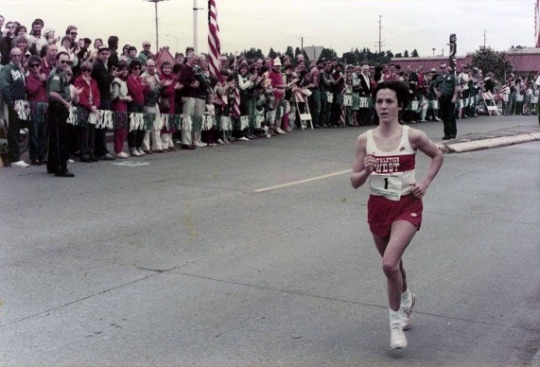

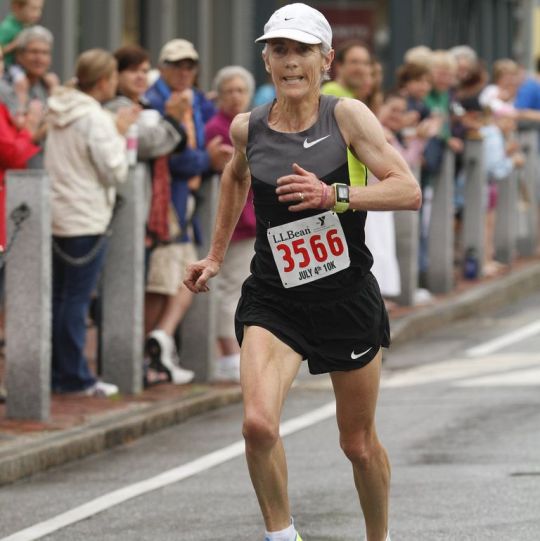
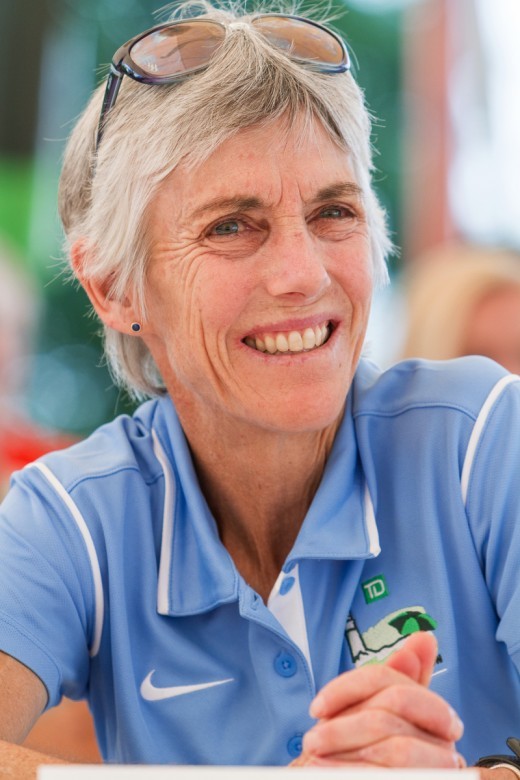
Well the pistons keep on turning And the wheels go round and round The steel rails are cold and hard For the miles that they go down
April 18, 1983
Joan Benoit wins her second Boston Marathon in the women’s division with a time of 2:22:43 on April 18, 1983. The following year, she went on to win the first-ever women’s marathon at the Summer Olympic Games in Los Angeles and became the first person to win Boston as well as Olympic gold.
A native of Maine, Benoit turned to long-distance running in high school after a ski injury. In 1979, as a senior at Bowdoin College, Benoit won her first Boston Marathon with a time of 2:35:15. Four years later, on April 18, 1983, Benoit won her second Boston Marathon, with a record time of 2:22:43. Greg Meyer of Massachusetts was the men’s winner that year, with a time of 2:09:00. As of 2007, Meyer was the last American man to win the Boston Marathon, which has been dominated by Kenyans in recent decades.
The inaugural Boston Marathon was run on April 19, 1897, and was a men-only event until 1972, when women were officially allowed to compete. The first female winner, Nina Kuscsik, finished with a time of 3:10:26 and was one of eight women who ran the race that year.
The first modern Olympic marathon was run at the 1896 Games in Athens. Eighty-eight years later, the first-ever women’s Olympic Marathon was run at the 1984 Summer Games in Los Angeles. Less than three weeks after undergoing arthroscopic knee surgery, Benoit won her Olympic trials. On August 5, 1984, she took home the gold medal with a time of 2:24:52, defeating Grete Waitz of Norway and Rosa Mota of Portugal.
Following the Olympics, Benoit returned to Maine, got married (and changed her name to Joan Benoit Samuelson) and had a family. In October 1985, she won the Chicago Marathon with a time of 2:21:21, setting a record that held for 21 years for the fastest U.S. female marathon time. After retiring from professional racing, she became a motivational speaker, author and commentator. In 2006, Benoit Samuelson helped pace champion cyclist Lance Armstrong in his first New York City Marathon.
Joan Benoit Samuelson is 62 years old and still runs
1 note
·
View note
Text
Margaret Okayo the Fastest Female Time in the Boston Marathon : Pure Tenacity
Name: Margaret Okayo Achievement: Fastest Female time in the Boston Marathon Boston Marathon winning year: 2002 Boston Marathon time: 2:20:43 In the annals of long-distance running, the name Margaret Okayo shines as a beacon of resilience, determination, and extraordinary talent. Hailing from the highlands of Kenya, Okayo’s story is one that exemplifies the triumph of the human spirit over…
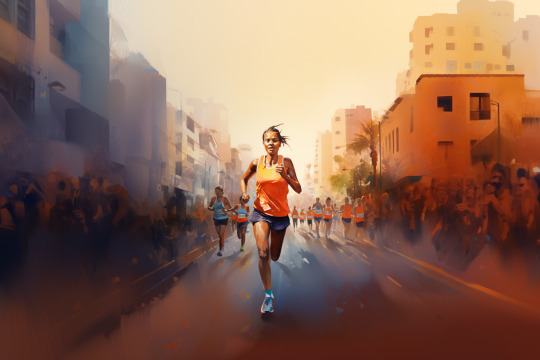
View On WordPress
#adversity#Assorted Flavors#Assorted Fruity Flavors#athlete#athlete&039;s journey#athletic legacy#Bekoji#best boston qualifying marathons#Boston Marathon#Buzunesh Deba#challenges#champion#chicago marathon#Clif Bar#Cycling#Cycling Snack#dedication#Determination#elite athlete#Endurance#Energy#Energy Chews#Ethiopia#Fast Fuel#Fastest Female time in the Boston Marathon#fastest woman#fastest womans time Boston Marathon#fastest womens time#full marathon#GU Energy
0 notes
Text
In A Pace Bunny’s Shoes
Just this past Sunday, I ran as a pace bunny for a full marathon, for the first time ever.

It’s worth noting that I have run as a pace bunny before, but only for a half-marathon. I knew the general duties and had a good grasp of how to control my pace. A full marathon, though, is twice that distance (the math checks out, even I can’t mess that one up) and the Edmonton Marathon is a much bigger event. There’s definitely a greater intimidation factor that comes along with it, even if pacing a 4:15 finish time, in the context of my own athletic ability, would be a walk in the park. I spent a lot of time leading up to the event... thinking.
Yeah, all philosophical and shit. Prior to pacing the Edmonton Marathon, I received some questions that I had been mulling over leading up to the event. Mainly along the lines of 1) How can I control my pace? and 2) Why even bother pacing a marathon? Or any race at all?
Number one is the easiest to answer. It takes practice and learning to take it easy. It takes time to appreciate running slow just as much as most people appreciate a fast run. Also, shoutout to my watch for doing all the work. Let’s be real, my internal clock isn’t that good (or good at all).

(please ignore the smear of energy gel on my face, I’m worse than a baby)
Number two, however, is the more interesting question.
Running is advertised as an incredibly independent sport. Insert Athlete’s Name Here does all of these things! They’re so fast! They’re sponsored by so and so! It’s not a wrong mentality when, in reality, it is just one person that we focus on from the start line to the finish line. Still, as a runner, I find that the moment I lose touch with the people around me is the moment the whole sport becomes a lot more difficult and a lot less enjoyable.
Running is not a team sport--this is the first impression that most people get, and yet in my own experience, I have discovered quite the opposite. I have fond memories of training with my entire team when I ran cross country and track in high school. My teammates pushed me to be better and stronger. Every time I’ve been close to a marathon finish line, there’s always someone beside me telling me I can do it, I can gun it to the end, I’ve got this. When I lived in BC, Kintec employees helped me pick out the best shoes, and here in Edmonton that turned into the Running Room. I’ve always had good morning and congratulations texts from my parents to look forward to, for every race.
The evidence doesn’t lie: even the best runners would struggle to succeed without a team to back them up. Olympic marathoners always thank their family and coaches. Eliud Kipchoge, the fastest marathoner, is backed up by an entire team as he takes on the INEOS 1:59 Challenge. It’s all right in front of us.
And yet, I’ve always found it difficult to express to people just how valuable a team can be, when it comes to running. Of course, actions speak louder than words, and that was how I first decided to run as a pace bunny. A way to pay it forward, for all of the years that I ran races and there were other people pacing me the entire way or giving me my stats as I passed a marker.
So out I went, ready to pace a full marathon. I had ran the Edmonton Marathon three times before, knew the course like the back of my hand. I had run my personal best on it, my Boston Qualifying time of 3:25:25. Physically speaking, finishing 4:15 was more than doable. The part that made me a little nervous was whether I had what it took to make the runners that wanted to stick with our group feel like they were strong enough to do so.
That’s what a running team does, at the end of the day. Every person, throughout training and to the very last step of the race, is there to make the runner feel as if they can take on anything. To make them feel stronger and run faster than they thought they could, and to make them proud of their achievement. And in order to prove to myself--and anyone else--that running is not the lone wolf trope people make it out to be, I knew I had to fill that role.
When the couple that had kept up with me and the other 4:15 pacer for most of the marathon came up to me afterwards to tell me how grateful they were and that I did a great job was the moment I realized I had accomplished just that.
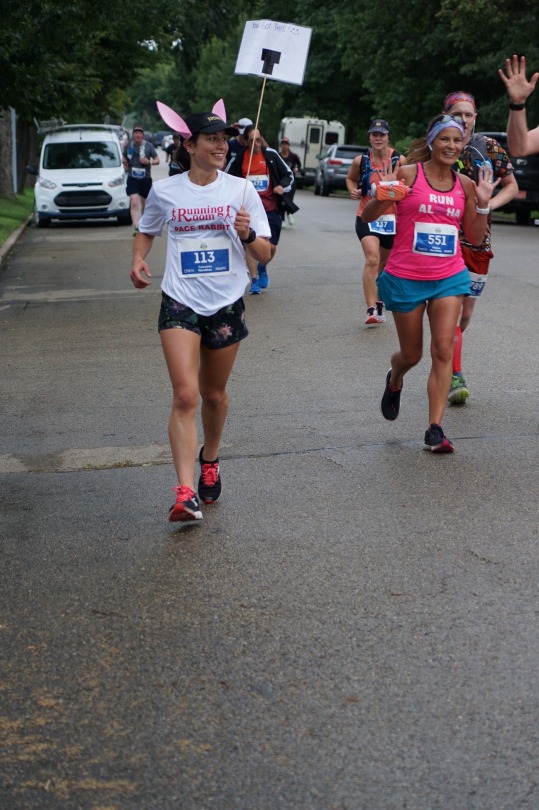
The race had been easy on my body and I had spent most of it cheering people on--both those in our group and those passing by us in the opposite direction. It had been fun and exciting. I saw a friend that I had helped train for the marathon, her very first one, tailing behind the 3:45 group. I saw other familiar faces that were enjoying the day. I talked to everyone in my own 4:15 group and got to know them all a little bit: the couple that always ran their marathons together, the retired woman running her first ever marathon on her birthday, the ultra-marathoner that had just done a timed ultra in Vegas a couple months prior.
There is no denying that racing is fun. I love speeding along a road, chasing PBs and pushing my limits. But enjoying these moments is important. Appreciating every person that came out to do something so challenging, cheering people on when they most need to hear it, encouraging them to stay ahead of you, to beat their own goals--focusing on other people and their relationship with running has done wonders for resetting my own passion. It’s incredibly easy to get wrapped up in technical talk and obsessive over every tiny little stat. Easy to fall victim to the same I Work Alone trope that everyone sees when they look at running, and therefore play a bigger role in perpetuating that very wrong impression instead of correcting it. This is toxic, though, and it can feed into something unhealthy. Taking the time to appreciate that the community is much bigger than me, to put my own desires on the back-burner and use my experience to help someone else, is a wonderful reminder of why I have been running for so long with no desire to give it up.
If you feel bored or unsatisfied in your running, if you feel your mind hitting a massive block every time your foot hits the pavement, take it as a sign that you need to do something different. Step back and do something for someone else. Explore a new trail with a friend or join a free run club. Volunteer to man an aid station for a race. Crew for someone running an ultra. Reset your perspective.
Healthy runners never work alone.
#celestinaruns#celestinarunsfitness#runblr#fitblr#running#runner#marathon#marathoner#marathon runner#edmonton#edmonton marathon#ultra marathon#trail runner#personal training#pace bunny#race rabbit#blog#running blog#healthblr
17 notes
·
View notes
Text
Pakistani duo makes history at Boston Marathon, sets Guinness World Record
Pakistan runners — Faisal Shafi (left) and Danish Elahi — celebrating their win after taking part in the world’s oldest Boston Marathon on April 21, 2025. — Reporter KARACHI: Two Pakistani runners, Faisal Shafi and Danish Elahi, made history at the world’s oldest Boston Marathon by setting a unique world record: completing the race in the fastest time while wearing traditional shalwar…
0 notes
Text
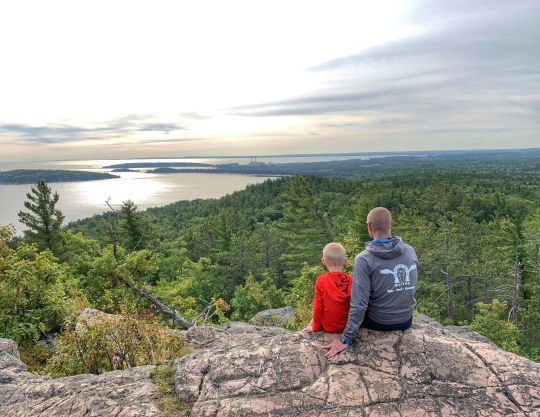




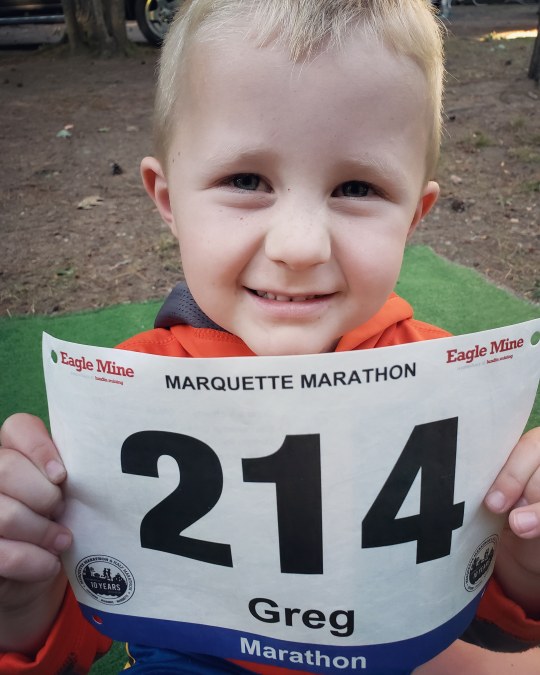
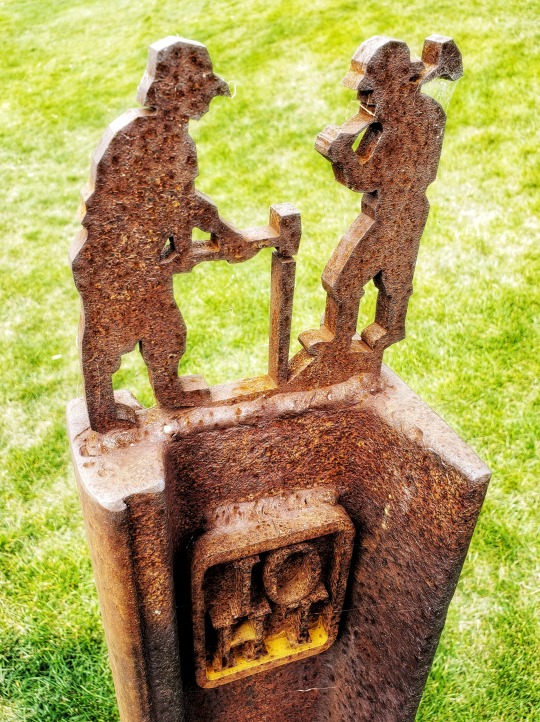

Looking back at another awesome weekend trip to Marquette. Lots of fun camping with everyone at Tourist Park. Hiked up Hogback with Laura and Sugarloaf with Jack. Watched the LS&I Iron Ore Train and visited the Ore Dock. Lots of bike rides and camp fires. Great time as always. It's definitely become a summer tradition.
Now on to the marathon. Again, it's been 4 years since my last stand alone road marathon. Trail running and road running are different beasts. Still, I thought a PR was very much in reach but would require some suffering along the way. What I didn't expect was to go out there and PR by over 10 minutes and feel great all day but that's how it went down. I never hit a low spot and looking back at it probably left a little bit of time out on the course. At mile 9 I stopped to tie my shoe. From that point on no one passed me but I made my way through the field.
This is such a great race with most of the race taking place on the Iron Ore Heritage Trail which is mostly paved but has some dirt/crushed rock. Someday I'm going to have to take my time on this trail and stop to read some of the mining history stops. I'm not the first to believe there's a strong connection between endurance sports and mining. That connection could be described in one word- grit. I guess that's one of the draws to places like Ishpeming/Negaunee/Marquette and out to the mountains of Leadville.
It might be a net downhill course but there are still some good hills in the final 3 miles especially Presque Isle and that final 1/2 mile slugfest up to the finish line on Third. At that point I emptied the tank and went for it. When I looked at my splits afterward I was surprised to see my last 3 miles were some of my fastest of the whole race.
Boston qualifying has never been a goal of mine which is probably a good thing because even after a 3:33 I'm still 18+ minutes away. That's alot of time. Still, I will admit this race has kind of left with this feeling of wanting to go for more.
3:33:34, 58 of 300 runners.
14 notes
·
View notes
Text
Ryan Hall To Be Coached By Jack Daniels

America's fastest marathoner puts an end to his self-coaching experiment.
On Monday afternoon, Ryan Hall revealed on he and his partner Sara's blog site that he is currently under the tutelage of famous coach Jack Daniels, thus ending a close to 4-year self-coaching job throughout which the 2:04:58 marathoner said he was letting his Christian belief influence as well as assist his training and racing decisions.
' I am enjoyed be collaborating with Jack as my coach,' Hall created. 'It has actually been an enjoyable trip over the last couple of years being self-coached and I have actually learned a great deal, but I seem like I am back in my old 'student self' shoes, anticipating saturate [ing] up every little thing Jack needs to say. Jack has already played a prominent duty in my growth as a runner, along with [with] hundreds as well as hundreds of others and also I am certain he could aid me return to my complete possibility as a marathon runner. With the Olympic Trials just a year as well as a fifty percent away it's time to start making progress towards my main goal as an athlete, to return to the Olympics and also be at my extremely most ideal there. This is something that has actually avoided me the last two Olympics yet I am hopeful and pregnant for the next years in advance with Jack's guidance.'
Hall, that has actually dealt with a string of unpleasant injuries and also inconsistent racing results over the previous three years, ran 2:04:58 to finish 4th at the 2011 Boston Marathon (the fastest time ever before run by an American, but it doesn't certify as the American record because of the downhill, point-to-point nature of Boston's program) as well as finished second to Meb Keflezighi at the 2012 UNITED STATE Olympic Trials in Houston. Given that the 2012 Trials, he's only finished one marathon, putting 20th in 2:17:50 at this previous April's Boston Marathon. While being self-coached, he and partner Sara have actually led a nomadic presence, mostly jumping between Flagtaff, Ariz., and also Redding, Calif., and also training in Ethiopia this past springtime before Boston. It is anticipated Hall will be based in Flagstaff, where both he and Daniels very own houses, as well as proceed prep works for a feasible fall marathon.
A 2005 Stanford graduate, Hall accomplished a few of his finest successes as an expert under coach Terrance Mahon as a participant of the Mammoth Track Club from 2005-2010. In 2007, Hall came to be the only American ever before to damage 60 mins for the fifty percent marathon, establishing a still-standing American document of 59:43. Later that springtime, Hall positioned 7th in the London Marathon, running 2:08:24, the fastest marathon debut ever before by an American. That November, he dominated the United States Olympic Tests at New york city City's Central Park, winning in a Trials record 2:09:02. And the following April, he ran 2:06:17 at the London Marathon, pacing fifth in the second-fastest time ever before run by an American as well as the fastest time ever run by an American-born citizen. After third and also 4th place coatings at the Boston Marathon in 2009 and 2010, Hall divided from Mahon as well as left the Mammoth Track Club and also has been greatly self-coached considering that, minus a quick job at the end of 2012 when he briefly dealt with famed Italian train Renato Canova.
Daniels, 81, has dealt with a loads of Olympic athletes over the program of his storied coaching occupation and also authored the best-selling publication, Daniels' Running Formula, now in its 3rd version. Best known for his collegiate coaching success at SUNY Cortland, where he led 30 specific Department III NCAA national champs, 8 NCAA national team champions and also 130 All-Americans over the training course of 17 years, Daniels is currently in his second year coaching the guys's and ladies's cross-country groups at Wells College in Aurora, New York.
1 note
·
View note
Text
An Illinois Marathon race recap of sorts
Instead of a traditional race recap, I thought I’d just write up some bullet points on the good and bad parts of this race (with some race photos thrown in for good measure, cuz they’re free!)

(This one is fun cuz it looks like I’m doing the robot)
What went wrong:
- I likely ran my long runs a bit slower/easier than I should have, and as a result my glutes weren’t used to working in the way that they do at marathon pace, even though I did a handful of MP runs.
- I didn’t have the base going into marathon training that I did for my last marathon. I was coming off three months of minimal running due to travel and a hamstring injury, and my 2018 running mileage was low in general due to Ironman training. I think marathons reward having months/years of base work more so than shorter race distances, so it makes sense that my speed improved at shorter distances but not in the marathon.
- Given these two things, I should have gone out more conservatively in the first half. Maybe if I’d gone out with the 3:30 pacer at the beginning things would have gone differently, and I could have slipped in under 3:30 with a small PR/BQ. I wanted a comfortable BQ though, which is why I started out more aggressively.
- I don’t know why, but I think I wasn’t there mentally on race day. I don’t think I believed I was going to have a good race; I was just hoping that once I got out there and was running everything would click.
- Less important, but there was a LOT of concrete in the first half of the race, and I think that played a small role in hurting so early too. I ended up wearing my more cushioned shoes and I’m so glad I did.

What went right:
- I am glad I picked this marathon. Champaign/Urbana is a cool area, and given the size of the race, I was surprised/impressed by how many spectators were out there cheering people on. Parking on race morning was super easy, and there were no lines at the Porto-potties I used before the race. I was immediately able to hit pace when the race started, and there was little to no weaving. I know this isn’t always the case for this race, but the weather was basically perfect too. The only downside is that when the half marathoners left us the race really thinned out, which was a bummer.
- I ran another marathon; a distance that honestly still seems ridiculous when I stop and think about it. I ran it in my second fastest time ever, at a pace I could have only dreamed of running a few years ago.
- I didn’t let myself completely give up. I know, a 10 minute positive split kinda seems like I did, but in between walking/stretching breaks when my glute was really hurting, I continued to run at an 8:XX pace. At least that’s what my watch said on the rare occasions I let myself look. 😂
- Building on that, the 3:35 pacer picked me up around mile 25. He had one person running with him, and asked me if I wanted to finish with them. I said I’d try, and we busted out one last 7:50 mile (the downhill on the last mile definitely helped too). At mile 26 I couldn’t push quite as hard as they did because I felt my calf starting to cramp. They waited for me at the finish though, and they seriously made the race so much better.

(You can see my new pals waiting for me here)
What’s next:
Looking at my training logs, my running volume has been about the same since 2016. Sure, there have been times where I was averaging in the upper 40s, but then there were times that I averaged in the mid 20s. I think I’ve gotten all the fitness I can out of averaging ~30 mi/week year round, and I need to start maintaining higher mileage year round to continue seeing improvements. Thanks to this marathon cycle I’m in a great place to maintain a 40MPW base over the summer, then build off of it for a fall marathon. But for now, I’m excited to recover, and just run for the fun of it. I considered signing up for a half Ironman this summer, but I think I’ll stick to shorter race distances instead. I want to race more often this summer, and take a break from the long stuff.

Although I’d like to go for a last minute BQ in August/September, I’m supposed to go to China for two weeks at the end of August, so the timing wouldn’t work out well. I really wanted to make it to Boston 2020 so I could say I ran it before I turned 30, but oh well. It was just an arbitrary goal anyway. Maybe in a couple weeks I’ll really believe that and will have moved on. 😊
#illinois marathon 2019#if you read all of this I am super impressed#and if you didn’t then I don’t blame you
28 notes
·
View notes
Photo
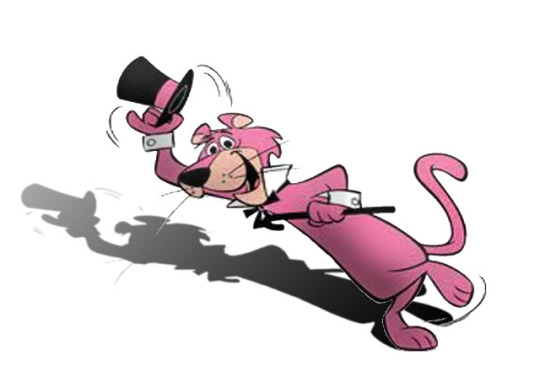
Postcards from Snagglepuss: Show us the way to the Moxie, and then some!
Our crew finally made it into Lisbon, Maine, largely via I-95 coming off the I-495 bypass of Boston, eventually segueing into the Maine Turnpike ... Exit 80 thereof, thereat, even, eventually reaching Maine 196, the gateway into the celebration of Moxie otherwise known as the Moxie Festival, the direct cause of this Character Convocation (and then some), in line with established practice, no doubt. And during the Thursday-evening checkin, yours truly, Huckleberry Hound and my Laff-A-Lympics compadre, Mildew Wolf, couldn't resist as much sipping on that foundation of "the good life" to the New England mindset as munching on plates of Cabot cheese from neighbouring Vermont on pilot biscuits ... which, believe you me, can certainly take plenty of moxie in and of itself rivalled only by actually managing to taste Moxie for the first time.
Which, for a few like Penelope Pitstop, April Stewart, Tina from Goober and the Ghost Chasers and Pepper from Clue Club, was likely Diet Moxie, which some insist has a harsher taste because of the sugar alternatives used like sucralose or aspertame than the original. But yet again, the crazy thing about Moxie, as I understand it, is the gentian root as is at the heart of the very taste behind Moxie. Which, as someone explained it to me, is widely recommended for digestive and stomachic problems, nasal and sinus issues and for diabeetus ... but when it first came out in 1884, Moxie boasted that it
[c]ontains not a drop of Medicine, Poison, Stimulant or Alcohol. But is a simple sugarcane-like plant grown near the Equator and farther south, was lately accidentally discovered by Lieut. Moxie and has proved itself to be the only harmless nerve food known that can recover brain and nervous exhaustion, loss of manhood, imbecility and helplessness. It has recovered paralysis, softening of the brain, locomotor ataxia, and insanity when caused by nervous exhaustion. It gives a durable solid strength, makes you eat voraciously, takes away the tired, sleepy, listless feeling like magic, removes fatigue from mental and physical over work at once, will not interfere with action of vegetable medicines.
"Makes you eat voraciously," huh ... Yours truly kind of likes that one. And so, I understand, doth Norville "Shaggy" Rogers and a certain Scooby-Doo, particularly with a few bags of Cheez Kurls to accompany weekend overnight horror-film marathons, the campier such, the better. And with plenty of concessions and food trucks around the Moxie Festival site, with such a bold claim as that, I just have to wonder how many of us are going to have enhanced appetites because Moxie. Especially for the likes of the local skin-on hot dogs, known as "Maine Snappers" because of the "snap" encountered when one bites into the casing--and with the buns being cut across the top rather than on the side. (As well as running for the Moxie just to wash it all down; as I noted, Moxie has long been favoured for stomach ailments, though it's largely Urban Legend more than anything.)
*************
Heavens to Frank Archer, and his inviting you to visit Moxieland out Boston way back in the day: While I was not aware of any cookery contests involving the rather bizarre-tasting soda, I could just swear that, for one, Peter Potamus could be seen basting a boneless ham with Moxie in a slow cooker, planning to fix some sandwiches for later on. And Bristlehound, not to be outdone, adding some Moxie to a pot roast (try explaining that to Mildew Wolf, forever a thorn in Bristlehound's side) ... not to mention, for novelty's sake, Augie Doggie and Doggie Daddy offering Moxie ice-cream floats and the Hair Bear Bunch, not to be outdone, fixing some sloppy joes with a dash of Moxie ("for the flavour"). Some of the visitors, I understand, were initially bewildered by such displays of Moxie cuisine way beyond the canon of Moxie epitomised by the Moxie Bottle Wagons, the Moxie Horsemobiles, and all manner of campy merchandise and advertising, especially when Moxie was advertised as "the Two-Minute Vacation" back in the day.
Canon, it turns out, that was nearly compromised when Moxie decided to corner the sugar markets for the flavouring syrup just before the Great Depression, only to miscalculate rather badly ... and nearly compromised further with reformulations in 1947 and 1968 as put off its loyal New England base to such extent that Moxie actually had to return to the original 1884 formula (howbeit, since 1960, absent sassafras, now considered to cause cancer) ... oh, and did I mention where MAD Magazine slipped in the Moxie logo in the backgrounds of its toons in the early 1960's with an eye to reclaiming public awareness of the brand, with sales in the New York City area alone increasing by 10% in the bargain?
As well as some of the cheesy advertising and ephemera for Moxie from "way back," no doubt attracting plenty of curiosity from the collectors' tables from quite a few of our Funtastic stable.
*************
One especially popular event at the Moxie Festival happens to be the Moxie Chugging Competition, which (officially) involves your standard 12-ounce can of Moxie, and trying to gulp it all down in competition against time without being put off by the taste. Yet for some reason, the idea among us Funtastics came about of trying to chug down one-litre bottles of the State Beverage of Maine, and seeing if the crowds would express disapproval, outrage even, at such stunts "not in the spirit of the Moxie canon."
The whole started, playfully enough, as a gag with The Banana Splits "themselves," the better to see who among them could seriously chug down the contents of a one-litre Moxie bottle fastest, and without discomfort (I hear it was Bingo who came up with the idea, silly as he can get). So, on Saturday afterlunch, in the middle of the carnival area for the Moxie Festival, all four of the Splits, plus Captain Caveman, Scooby-Doo, Big H and The King "himself"--and, for good measure, Yogi Bear--set upon the challenge with a one-litre bottle of Moxie. (The two-litre bottle was initially considered, but was rejected as probably being too much for many of us to stomach. Pun accidental.)
Still, it's not easy to expect to chug down a bottle of Moxie in one gulp, especially considering that the taste requires some serious acclimation; in coming up with this particular Convocation, yours truly purchased a case of six-pack Moxie cans from a Long Beach grocers' specialist in New England staples, and quenched his thirst galore with the concoction. Still, given the taste, you need to pace yourself.
(As if that weren't enough, I understand Top Cat and clowder acknowledged missing the old Moxie from back in Brooklyn, and how good such can taste with some grilled Italian sausage in the Brooklyn fashion.) (And returning to The Banana Splits for a moment, Snorky came up with a rather imaginative approach to using his trunk to grasp the bottle.)
By the time it was all over, replete with dumb looks from festival goers as much as requests for selfies holding cans and/or bottles of Moxie--you probably wouldn't have been interested. But what was interesting was that even the Skatebirds, the Cattanooga Cats and the Bungle Brothers couldn't resist the shaved-ham-in-Moxie sandwiches from Peter Potamus, rather generously stacked. And Sis and Honey, on their pop-up shortwave radio station's Saturday broadcast, raving (over Diet Moxie, no doubt) over Bristlehound giving pot roast a new twist of flavour with as much garlic and herbs as Moxie ("even the gravy had that irresistably Down East tang of gentian root extract," as Sis effused).
*************
One thing as was not worth forgetting about was encouraging the Funtastics in attendance to make sure they stocked up on a case or two of Moxie to head back home to, considering that Moxie (and Diet Moxie, let's not forget about them) isn't that easy to find in stores outside the New England region. As well as a case "for the road," in the bargain--not to mention a case of "Maine snapper" hot dogs (packed in dry ice, at any rate) and a bag or two of Humpty Dumpty Potato Chips, another Old Dirigo snacktime staple. Yet even then, Huck and I had to wonder whether it was going to be easy for many such to head back with so much Moxie WITHOUT causing a lot of axle strain in the bargain, evident only when it would be least expected. (One likely exception: The Cattanooga Cats, who decided to get only a couple cases of Moxie considering their impartiality to RC Cola and Moon Pies in classic Southern mindset.)
Even as it was just winding down, yours truly had to admit that Moxie was a bit wicked-tasting ... even as the next adventures await. Likely via the Minnesota State Fair, again. Exit, stage right ...
#fanfic#hanna barbera#snagglepuss#postcards#convocation#get together#moxie#moxie festival#cooking with moxie#moxie chugging#maine snappers#moxie recipes#make mine moxie for me#live your life with moxie#mad about moxie#diet moxie#humpty dumpty potato chips#down east#old dirigo#maine thing
1 note
·
View note